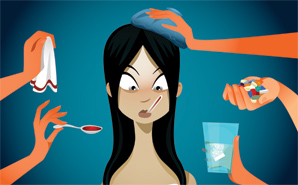
Image: iStockphoto
Once again, the dynamic ER duo Dr. Brady Pregerson and Nurse Rebekah Child are back and ready to compare notes on the superbug MRSA. But first, they release some of the tension surrounding this very serious issue with a frank and open discussion on the experience of treating ‘abscess al Kahuna.’
Is MRSA the most repulsive epidemic to find its way into the ER? Or is treating the nasty bump a perversely spectacular highlight of patient care?
Between our ER doc, Brady Pregerson, and our sassy nurse, Rebekah Child, they talk about the causes of MRSA, remind us of the seriousness and scope of the MRSA problem, and give some easy tips for nurses to help fight the spread of this nasty epidemic.
RN: So I was at the gym today (finally a day off!), and I was half watching the Oprah show and half watching this really sweaty guy because I thought he was going to fall off the treadmill and code. (Side note: Please, people, if you haven’t been to the gym since 2003, for the sake of us medical personnel, don’t go full blast on your first time out. You’re just giving all of us angina.). The topic of Oprah’s discussion was MRSA, and the more I thought about the perils of MRSA and the more I watched Mr. I’m-Gonna-Lose-70-Pounds-Today, who was sweating his own saltwater pool, the more I was reminded of my first encounter with an MRSA patient a number of years ago.
She was a young girl who was an avid spinner, and couldn’t attend her favorite gym class of late due to this ever-growing, ever-painful red lump on her right buttock. So she came to the ED, and lo and behold, it was a pretty good-size abscess. When the doc injected the lidocaine, it was just enough to release some much pent-up pressure. There, from this young girl’s haunches, sprung forth a fountain of blood and pus similar to the fountains at The Bellagio, but without the obvious beauty and background vocals of Celine Dion and Andrea Bocelli. An obsession was born.
MD: Ew, I hate this stuff. I guess some people like to watch the stuff drain, but honestly, the stuff is stinky and awful. What’s more, I hate to have to drain an abscess, because even though I know I’m helping the patient, I have to be cruel to be kind. I always give some morphine or dilaudid first unless they have to drive home, but that injection still hurts. You nurses are lucky here. You don’t have to inject the lidocaine (it burns) and you can stand a few feet back from the bubbling pus.
RN: Yes, the lido burns, but put a little neut in it! I still don’t understand why this isn’t done all the time. I have since become what I like to call an abscess aficionado. I can usually tell by the amount of pus and the smell whether it is MRSA or not. I have a hard and fast rule: No doc is allowed to I&D my patients without my presence because it’s like missing the opening act of the Academy Awards—the best part!
MD: When I treat a patient for an abscess, it’s definitely a teachable moment. They never want to have to come back for another I&D. So I tell them how they can avoid this in the future: Keep clean, shower often and never pick or squeeze anything unless you wash your hands immediately beforehand and immediately afterward. People just don’t understand how dirty their hands and fingernails are. Even with no visible dirt, per se, Staph aureus is lurking around every corner.
RN: Over the years, we’ve seen MRSA grow from a hospital problem into a community problem. This nasty mutant bug can very easily be picked up from the gym (sweaty bottom + tiny, dirty seat + open pores = trip to the ED for serious antibiotics). Average, ordinary people are contracting this insolent bacteria and just can’t shake it.
MD: Although Staph aureus infections have been around since before the dark ages, and even yours truly had to go to the emergency department as a teenager for the type of cure only a gleaming 11-blade can offer, we’re definitely in the midst of an MRSA epidemic. And unlike some of the other current epidemics such as HIV and hepatitis C, which primarily target those who share needles or don’t protect themselves during sex, MRSA targets everyone.
Athletes are definitely at risk, but so are we.
In fact, as healthcare workers, we’re probably at higher risk than most. A friend of mine who’s a nurse developed an MRSA infection after a minor hand surgery. We’re around it every day. So if we don’t take the proper precautions, it means trouble.
I’m almost tired of all the articles on the subject. I get it. I should wash my hands frequently at work, and when I get home, wash everything else. And of course, taking precautionary measures during patient care, including using the correct barriers when dealing with open lesions and putting patients with a history of MRSA infection on isolation to protect patients and staff.
RN: I can’t help but wonder what part we played in this growing problem. I always try to emphasize to my patients on discharge that they MUST TAKE ALL OF THEIR ANTIBIOTICS. Don’t stop taking them when you feel better, don’t save them for another sick day, don’t give up if you miss a dose. Keep going until the bottle is empty! I try to explain to them about these mutant bugs and how serious they are. I also wonder what doctors have done, or haven’t done, to prevent this. Sometimes, people just demand an antibiotic even when everyone from the ED volunteers to the cafeteria staff knows that this person has a virus and, thus, antibiotics are useless. But some docs give in, most likely to win the battle, even though in the long run they may lose the war.
MD: Not me! I know the data. Ninety-five percent of respiratory infections are caused by viruses, and 75 percent of the inappropriate antibiotics in this country are written for URIs. I find that most patients will trust me that they don’t need antibiotics if I take the time to explain why. It takes a few extra minutes of my time, something that is precious at work, but I think it’s worth it. I have a whole shpiel I give, which I won’t reproduce here, and it usually works. I want to win both the battle and the war. I want to be part of the solution and the cure. Of course, it doesn’t always work, but I’m batting around 900 these days. For abscesses, there’s a bit more controversy. According to most experts, simple abscesses actually don’t require antibiotics after an I&D. However, there is data to suggest that antibiotics may help eradicate the carrier state that exists between acute infections. Sounds worth it to me.
RN: One thing nurses and doctors can always do better is wash their hands. I’m going to go out on an anecdotal limb here and say that nurses are better at being hygienic than doctors are. Actually, that’s not really a limb—it has been shown in quite a few studies—but we’ll have to save that for a future installment of MD/RN! Have a great day, people, and remember: Stay safe, stay sanitized.

















